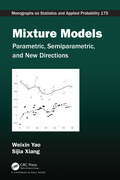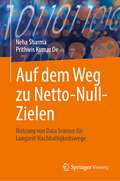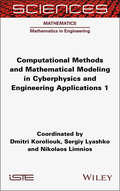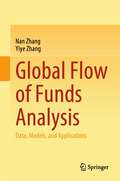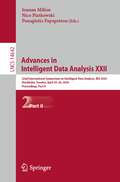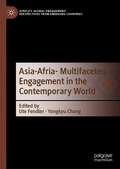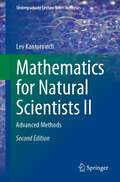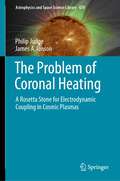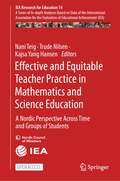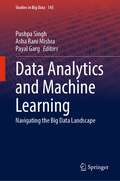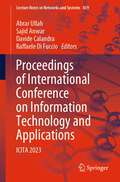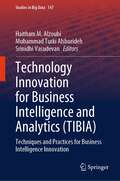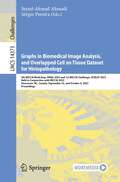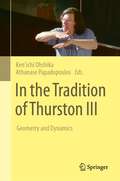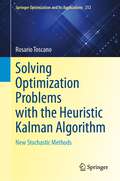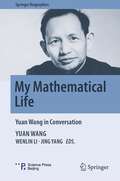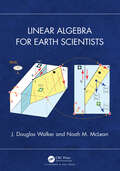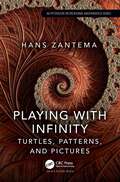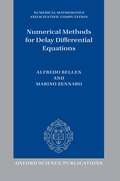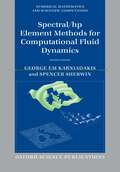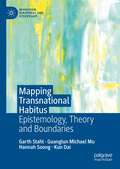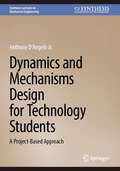- Table View
- List View
Mixture Models: Parametric, Semiparametric, and New Directions (ISSN)
by Weixin Yao Sijia XiangMixture models are a powerful tool for analyzing complex and heterogeneous datasets across many scientific fields, from finance to genomics. Mixture Models: Parametric, Semiparametric, and New Directions provides an up-to-date introduction to these models, their recent developments, and their implementation using R. It fills a gap in the literature by covering not only the basics of finite mixture models, but also recent developments such as semiparametric extensions, robust modeling, label switching, and high-dimensional modeling. Features Comprehensive overview of the methods and applications of mixture models Key topics include hypothesis testing, model selection, estimation methods, and Bayesian approaches Recent developments, such as semiparametric extensions, robust modeling, label switching, and high-dimensional modeling Examples and case studies from such fields as astronomy, biology, genomics, economics, finance, medicine, engineering, and sociology Integrated R code for many of the models, with code and data available in the R Package MixSemiRob Mixture Models: Parametric, Semiparametric, and New Directions is a valuable resource for researchers and postgraduate students from statistics, biostatistics, and other fields. It could be used as a textbook for a course on model-based clustering methods, and as a supplementary text for courses on data mining, semiparametric modeling, and high-dimensional data analysis.
Mixture Models: Parametric, Semiparametric, and New Directions (ISSN)
by Weixin Yao Sijia XiangMixture models are a powerful tool for analyzing complex and heterogeneous datasets across many scientific fields, from finance to genomics. Mixture Models: Parametric, Semiparametric, and New Directions provides an up-to-date introduction to these models, their recent developments, and their implementation using R. It fills a gap in the literature by covering not only the basics of finite mixture models, but also recent developments such as semiparametric extensions, robust modeling, label switching, and high-dimensional modeling. Features Comprehensive overview of the methods and applications of mixture models Key topics include hypothesis testing, model selection, estimation methods, and Bayesian approaches Recent developments, such as semiparametric extensions, robust modeling, label switching, and high-dimensional modeling Examples and case studies from such fields as astronomy, biology, genomics, economics, finance, medicine, engineering, and sociology Integrated R code for many of the models, with code and data available in the R Package MixSemiRob Mixture Models: Parametric, Semiparametric, and New Directions is a valuable resource for researchers and postgraduate students from statistics, biostatistics, and other fields. It could be used as a textbook for a course on model-based clustering methods, and as a supplementary text for courses on data mining, semiparametric modeling, and high-dimensional data analysis.
Auf dem Weg zu Netto-Null-Zielen: Nutzung von Data Science für Langzeit-Nachhaltigkeitswege
by Neha Sharma Prithwis Kumar DeDieses Buch diskutiert die Verwendung von Technologie, Data Science und Open Data, um das Netto-Null-Emissionsziel des Pariser Abkommens zum Klimawandel zu erreichen. Es gibt viele Diskussionen über Nachhaltigkeit und Lösungen für den Klimawandel, um die negativen Auswirkungen zu mildern. Die Verwendung von Technologiehebeln zur Bewältigung von Klimaherausforderungen wird jedoch selten als der bedeutendste Katalysator betrachtet. Die verfügbare Forschung in diesem Bereich ist im Allgemeinen qualitativer Natur, bei der Technologie und Daten noch nicht genutzt wurden. Durch den Einsatz von KI/ML sagt das Buch die Klimawandelfolgen aufgrund von Investitionen in den fossilen Brennstoffsektor voraus, schätzt die CO2-Emissionen des Verkehrssektors, prognostiziert die durch nicht erneuerbare Energiequellen verursachte durchschnittliche Landtemperatur und segmentiert indische Bundesstaaten auf der Grundlage von Haushalts-CO2-Emissionen. Die Forscher, Entscheidungsträger, Studenten, Lehrer, Bildungseinrichtungen, Regierungen, Regulierungsbehörden, Unternehmen, internationale Organisationen usw. werden immens von diesem Buch profitieren. Darüber hinaus soll dieses Buch dazu dienen, den nächsten Generationen eine dekarbonisierte Umgebung und eine bessere Zukunft zu bieten.
Computational Methods and Mathematical Modeling in Cyberphysics and Engineering Applications 1
by Dmitri Koroliouk Sergiy Lyashko Nikolaos LimniosMathematical methods in engineering are characterized by a wide range of techniques for approaching various problems. Moreover, completely different analysis techniques can be applied to the same problem, which is justified by the difference in specific applications. Therefore, the study of the analyses and solutions of specific problems leads the researcher to generate their own techniques for the analysis of similar problems continuously arising in the process of technical development. Computational Methods and Mathematical Modeling in Cyberphysics and Engineering Applications contains solutions to specific problems in current areas of computational engineering and cyberphysics.
Global Flow of Funds Analysis: Data, Models, and Applications
by Nan Zhang Yiye ZhangThis book is the first to focus on the global flow of funds (GFF), providing an introduction to its fundamental concepts and establishing a theoretical framework for analysis. It connects the flow of funds within domestic economies to that of the rest of the world, offering a comprehensive analysis of GFF dynamics. This study enhances GFF statistics, enabling the assessment of global financial stability from both national and cross-border sectoral perspectives. The GFF data provide valuable insights into analyzing interconnectivity across borders and an understanding of global financial interdependencies. By examining the data sources and reconstructing the statistical framework to establish the GFF statistical matrix, this book conducts a case study to evaluate financial risks and influences in G20 countries. Subsequently, it connects the GFF matrix with sectoral account data and the flow of funds to establish the sectoral from-whom-to-whom financial stock matrix (SFSM). The SFSM aims to establish a new framework for conducting multi-country, multi-sector analysis within the G20, with a special emphasis on examining the national and cross-border exposures of sectors in China, Japan, and the USA. This involves constructing country-specific financial networks and connecting them based on cross-border exposures. The systematic analysis results effectively showcase the financial interconnections among G20 countries within the GFF and shed light on the attributes of external shocks and internal influences. The focus is particularly on the changes in risk exposure between China and the USA concerning their external assets and liabilities and the implications of economic decoupling of these dynamics.
Advances in Intelligent Data Analysis XXII: 22nd International Symposium on Intelligent Data Analysis, IDA 2024, Stockholm, Sweden, April 24–26, 2024, Proceedings, Part II (Lecture Notes in Computer Science #14642)
by Ioanna Miliou Nico Piatkowski Panagiotis PapapetrouThe two volume set LNCS 14641 and 14642 constitutes the proceedings of the 22nd International Symposium on Intelligent Data Analysis, IDA 2024, which was held in Stockholm, Sweden, during April 24-26, 2024. The 40 full and 3 short papers included in the proceedings were carefully reviewed and selected from 94 submissions. IDA is an international symposium presenting advances in the intelligent analysis of data. Distinguishing characteristics of IDA are its focus on novel, inspiring ideas, its focus on research, and its relatively small scale.
Asia-Afria- Multifaceted Engagement in the Contemporary World (Africa's Global Engagement: Perspectives from Emerging Countries)
by Ute Fendler Yongkyu ChangThis book provides an insight into the complex entanglements between African countries and India, China, and South Korea from multidisciplinary perspectives connecting approaches from cultural, anthropological, literary, and music studies and art history. The three parts present a regional focus, namely Africa-India, Africa-South Korea, and Africa-China while the single contributions speak to each other and offer complementary insights. At the same time, the chapters also link across the regional realms as they deal with similar topics, such as travelling music genres. In part I, for Pombo material culture is the starting point to investigate the connections between the islands of the Indian Ocean and India by questioning the construction of memory. It highlights various aspects of the multilayered history of connections between Africa, the islands, and India. Part II gathers contributions that are complimentary to each other and therefore contribute to the understanding of the complex entanglements in area studies. Part III (Africa-South Korea) explores the impact of African-American arts and artists on South Korea's popular culture as well as the changing perception of artists of African descent in visual popular culture. It shows the impact of Korean content in South Africa.
Mathematics for Natural Scientists II: Advanced Methods (Undergraduate Lecture Notes in Physics)
by Lev KantorovichThis textbook, the second in a series (the first covered fundamentals and basics), seeks to make its material accessible to physics students. Physics/engineering can be greatly enhanced by knowledge of advanced mathematical techniques, but the math-specific jargon and laborious proofs can be off-putting to students not well versed in abstract math. This book uses examples and proofs designed to be clear and convincing from the context of physics, as well as providing a large number of both solved and unsolved problems in each chapter. This is the second edition, and it has been significantly revised and enlarged, with Chapters 1 (on linear algebra) and 2 (on the calculus of complex numbers and functions) having been particularly expanded. The enhanced topics throughout the book include: vector spaces, general (non-Hermitian, including normal and defective) matrices and their right/left eigenvectors/values, Jordan form, pseudoinverse, linearsystems of differential equations, Gaussian elimination, fundamental theorem of algebra, convergence of a Fourie series and Gibbs-Wilbraham phenomenon, careful derivation of the Fourier integral and of the inverse Laplace transform. New material has been added on many physics topics meant to illustrate the maths, such as 3D rotation, properties of the free electron gas, van Hove singularities, and methods for both solving PDEs with a Fourier transform and calculating the width of a domain wall in a ferromagnet, to mention just a few. This textbook should prove invaluable to all of those with an interest in physics/engineering who have previously experienced difficulty processing the math involved.
The Problem of Coronal Heating: A Rosetta Stone for Electrodynamic Coupling in Cosmic Plasmas (Astrophysics and Space Science Library #470)
by Philip Judge James A. IonsonThis book reflects on 8 decades of research on one of the longest-standing unsolved problems in modern astrophysics: why does the Sun form a hot corona? The authors give a critical overview of the field and offer suggestions on how to bridge the chasm between what we can measure, and what we can calculate. They go back to basics to explain why the problem is difficult, where we have made progress and where we have not, to help the next generation of scientists devise novel techniques to crack such a long-lasting problem. A way forward is formulated centered around refutation, using Bayesian methods to propose and to try to reject hypotheses and models, and avoiding seduction by ``confirmation bias’’.This book is aimed at physicists, students and researchers interested in understanding, learning from and solving the coronal heating problem, in an era of new dedicated facilities such as the Parker Solar Probe and the Daniel K. Inouye Solar Telescope. Thebook will appeal to those interested in understanding research methods and how they are changing in the modern academic environment, particular in astrophysics and Earth sciences where remote sensing is essential.
Effective and Equitable Teacher Practice in Mathematics and Science Education: A Nordic Perspective Across Time and Groups of Students (IEA Research for Education #14)
by Nani Teig Trude Nilsen Kajsa Yang HansenThis open access book presents original research on effective and equitable teacher practice in mathematics and science education across Nordic countries. It focuses on three key aspects of teacher practice: what teachers teach, how teachers teach, and how teachers assess their students.To provide a comprehensive understanding of teacher practice, data from the IEA’s Trends in Mathematics and Science Study (TIMSS) from 2011 to 2019 was analyzed. TIMSS provides large-scale and representative data, allowing an in-depth investigation of the relations between teachers, their practices, and student outcomes. The findings highlight the changes in teacher practice over time and the extent to which such changes explain the differences in student outcomes. This research also contributes to understanding how the relationships between teacher practice and student outcomes vary across different student groups (i.e., gender, socioeconomic status, and language background). The empirical evidence presented not only adds a significant layer to the academic discourse but also offers practical implications. These insights are crucial in facilitating educational policymaking and classroom practices aimed at improving student outcomes and closing gaps in educational inequality.
Data Analytics and Machine Learning: Navigating the Big Data Landscape (Studies in Big Data #145)
by Pushpa Singh Asha Rani Mishra Payal GargThis book presents an in-depth analysis of successful data-driven initiatives, highlighting how organizations have leveraged data to drive decision-making processes, optimize operations, and achieve remarkable outcomes. Through case studies, readers gain valuable insights and learn practical strategies for implementing data analytics, big data, and machine learning solutions in their own organizations. The book discusses the transformative power of data analytics and big data in various industries and sectors and how machine learning applications have revolutionized exploration by enabling advanced data analysis techniques for mapping, geospatial analysis, and environmental monitoring, enhancing our understanding of the world and its dynamic processes. This book explores how big data explosion, the power of analytics and machine learning revolution can bring new prospects and opportunities in the dynamic and data-rich landscape. It highlights the future research directions in data analytics, big data, and machine learning that explores the emerging trends, challenges, and opportunities in these fields by covering interdisciplinary approaches such as handling and analyzing real-time and streaming data.
Proceedings of International Conference on Information Technology and Applications: ICITA 2023 (Lecture Notes in Networks and Systems #839)
by Abrar Ullah Sajid Anwar Davide Calandra Raffaele Di FuccioThis book includes high-quality papers presented at 17th International Conference on Information Technology and Applications (ICITA 2023), held in Turin, Italy during 20 – –22 October 2023. The book presents original research work of academics and industry professionals to exchange their knowledge of the state-of-the-art research and development in information technology and applications. The topics covered in the book are cloud computing, business process engineering, machine learning, evolutionary computing, big data analytics, internet of things and cyber-physical systems, information and knowledge management, computer vision and image processing, computer graphics and games programming, mobile computing, ontology engineering, software and systems modelling, human computer interaction, online learning /e-learning, computer networks, and web engineering.
Technology Innovation for Business Intelligence and Analytics: Techniques and Practices for Business Intelligence Innovation (Studies in Big Data #147)
by Haitham M. Alzoubi Muhammad Turki Alshurideh Srinidhi VasudevanThis book provides a standpoint on how to effectively use technology innovation for business intelligence and analytics. It presents an approach that combines cutting-edge technological advancements with practical applications in the business world. The book covers a range of innovative technologies and how they can be applied to enhance business intelligence and analytics. It is primarily aimed at professionals in the business field data analysts and students studying subjects. This book is especially beneficial for those who want to grasp and apply the technological trends in making strategic business decisions. Its comprehensive coverage makes it an indispensable resource for anyone, in the intersection of technology and business analytics.
Graphs in Biomedical Image Analysis, and Overlapped Cell on Tissue Dataset for Histopathology: 5th MICCAI Workshop, GRAIL 2023 and 1st MICCAI Challenge, OCELOT 2023, Held in Conjunction with MICCAI 2023, Vancouver, BC, Canada, September 23, and October 4, 2023, Proceedings (Lecture Notes in Computer Science #14373)
by Seyed-Ahmad Ahmadi Sérgio PereiraThis LNCS conference volume constitutes the proceedings of the MICCAI Workshop GRAIL 2023 and MICCAI Challenge OCELOT 2023, Held in Conjunction with MICCAI 2023, Vancouver, BC, Canada, September 23, and October 4, 2023. The 9 full papers (GRAIL 2023) and 6 full papers (OCELOT 2023) included in this volume were carefully reviewed and selected from GRAIL 14 (GRAIL 2023) and 6 (OCELOT 2023) submissions. The conference GRAIL 2023 a wide set of methods and application and OCELOT 2023 focuses on the cover a wide range of methods utilizing tissue information for better cell detection, in the sense of training strategy, model architecture, and especially how to model cell-tissue relationships.
In the Tradition of Thurston III: Geometry and Dynamics
by Ken’ichi Ohshika Athanase PapadopoulosWilliam Thurston’s ideas have altered the course of twentieth century mathematics, and they continue to have a significant influence on succeeding generations of mathematicians. The purpose of the present volume and of the other volumes in the same series is to provide a collection of articles that allows the reader to learn the important aspects of Thurston’s heritage. The topics covered in this volume include Kleinian groups, holomorphic motions, earthquakes from the Anti-de Sitter point of view, the Thurston and Weil–Petersson metrics on Teichmüller space, 3-manifolds, geometric structures, dynamics on surfaces, homeomorphism groups of 2-manifolds and the theory of orbifolds.
Solving Optimization Problems with the Heuristic Kalman Algorithm: New Stochastic Methods (Springer Optimization and Its Applications #212)
by Rosario ToscanoThis text focuses on simple and easy-to-use design strategies for solving complex engineering problems that arise in several fields of engineering design, namely non-convex optimization problems. The main optimization tool used in this book to tackle the problem of nonconvexity is the Heuristic Kalman Algorithm (HKA). The main characteristic of HKA is the use of a stochastic search mechanism to solve a given optimization problem. From a computational point of view, the use of a stochastic search procedure appears essential for dealing with non-convex problems.The topics discussed in this monograph include basic definitions and concepts from the classical optimization theory, the notion of the acceptable solution, machine learning, the concept of preventive maintenance, and more. The Heuristic Kalman Algorithm discussed in this book applies to many fields such as robust structured control, electrical engineering, mechanical engineering, machine learning, reliability, and preference models. This large coverage of practical optimization problems makes this text very useful to those working on and researching systems design. The intended audience includes industrial engineers, postgraduates, and final-year undergraduates in various fields of systems design.
My Mathematical Life: Yuan Wang in Conversation (Springer Biographies)
by Yuan WangThis book is an autobiographical interview with Chinese Academician Yuan Wang on his experience in mathematical research. The book looks back on Wang's collaboration with his teacher Hua Loo-Keng and younger scholars, offering insights into fruitful cooperation in mathematical research.In this book, Yuan Wang’s path of studying Goldbach conjecture is revealed in detail from motivation to method. Then his work on algebraic number theory is traced back in a separate chapter. The book ends with two chapters which introduce Wang’s interest in history of mathematics and his hobbies outside of mathematical research. Wang shows how a mathematician can in the same time be a historical and popular science writer and, in particular, a well-received calligrapher. The book is intended for undergraduate and graduate students studying number theory. Researchers who are willing to learn from the experience of an established mathematician, as well as math amateurs and general audience who are interested in Yuan Wang's life story might also find this book appealing.
Linear Algebra for Earth Scientists
by J. Douglas Walker Noah M. McLeanLinear Algebra for Earth Scientists is written for undergraduate and graduate students in Earth and Environmental sciences. It is intended to give students enough background in linear algebra to work with systems of equations and data in geology, hydrology, geophysics, or whatever part of the Earth Sciences they engage with.The book does not presuppose any extensive prior knowledge of linear algebra. Instead, the book builds students up from a low base to a working understanding of the sub t that they can apply to their work, using many familiar examples in the geosciences.Features Suitable for students of Earth and Environmental Sciences Minimal prerequisites — written in a way that is accessible and engaging for those without a mathematical background All material presented with examples and applications to the Earth Sciences
Linear Algebra for Earth Scientists
by J. Douglas Walker Noah M. McLeanLinear Algebra for Earth Scientists is written for undergraduate and graduate students in Earth and Environmental sciences. It is intended to give students enough background in linear algebra to work with systems of equations and data in geology, hydrology, geophysics, or whatever part of the Earth Sciences they engage with.The book does not presuppose any extensive prior knowledge of linear algebra. Instead, the book builds students up from a low base to a working understanding of the sub t that they can apply to their work, using many familiar examples in the geosciences.Features Suitable for students of Earth and Environmental Sciences Minimal prerequisites — written in a way that is accessible and engaging for those without a mathematical background All material presented with examples and applications to the Earth Sciences
Playing with Infinity: Turtles, Patterns, and Pictures (AK Peters/CRC Recreational Mathematics Series)
by Hans ZantemaThis is a book about infinity - specifically the infinity of numbers and sequences. Amazing properties arise, for instance, some kinds of infinity are argued to be greater than others. Along the way the author will demonstrate how infinity can be made to create beautiful ‘art’, guided by the development of underlying mathematics. This book will provide a fascinating read for anyone interested in number theory, infinity, math art, and/or generative art, and could be used a valuable supplement to any course on these topics.Features: Beautiful examples of generative art Accessible to anyone with a reasonable high school level of mathematics Full of challenges and puzzles to engage readers
Playing with Infinity: Turtles, Patterns, and Pictures (AK Peters/CRC Recreational Mathematics Series)
by Hans ZantemaThis is a book about infinity - specifically the infinity of numbers and sequences. Amazing properties arise, for instance, some kinds of infinity are argued to be greater than others. Along the way the author will demonstrate how infinity can be made to create beautiful ‘art’, guided by the development of underlying mathematics. This book will provide a fascinating read for anyone interested in number theory, infinity, math art, and/or generative art, and could be used a valuable supplement to any course on these topics.Features: Beautiful examples of generative art Accessible to anyone with a reasonable high school level of mathematics Full of challenges and puzzles to engage readers
Numerical Methods for Delay Differential Equations (Numerical Mathematics and Scientific Computation)
by Alfredo Bellen Marino ZennaroThe main purpose of the book is to introduce the readers to the numerical integration of the Cauchy problem for delay differential equations (DDEs). Peculiarities and differences that DDEs exhibit with respect to ordinary differential equations are preliminarily outlined by numerous examples illustrating some unexpected, and often surprising, behaviours of the analytical and numerical solutions. The effect of various kinds of delays on the regularity of the solution is described and some essential existence and uniqueness results are reported. The book is centered on the use of Runge-Kutta methods continuously extended by polynomial interpolation, includes a brief review of the various approaches existing in the literature, and develops an exhaustive error and well-posedness analysis for the general classes of one-step and multistep methods. The book presents a comprehensive development of continuous extensions of Runge-Kutta methods which are of interest also in the numerical treatment of more general problems such as dense output, discontinuous equations, etc. Some deeper insight into convergence and superconvergence of continuous Runge-Kutta methods is carried out for DDEs with various kinds of delays. The stepsize control mechanism is also developed on a firm mathematical basis relying on the discrete and continuous local error estimates. Classical results and a unconventional analysis of "stability with respect to forcing term" is reviewed for ordinary differential equations in view of the subsequent numerical stability analysis. Moreover, an exhaustive description of stability domains for some test DDEs is carried out and the corresponding stability requirements for the numerical methods are assessed and investigated. Alternative approaches, based on suitable formulation of DDEs as partial differential equations and subsequent semidiscretization are briefly described and compared with the classical approach. A list of available codes is provided, and illustrative examples, pseudo-codes and numerical experiments are included throughout the book.
Spectral/hp Element Methods for Computational Fluid Dynamics: Second Edition (Numerical Mathematics and Scientific Computation)
by George Karniadakis Spencer SherwinSpectral methods have long been popular in direct and large eddy simulation of turbulent flows, but their use in areas with complex-geometry computational domains has historically been much more limited. More recently the need to find accurate solutions to the viscous flow equations around complex configurations has led to the development of high-order discretisation procedures on unstructured meshes, which are also recognised as more efficient for solution of time-dependent oscillatory solutions over long time periods. Here Karniadakis and Sherwin present a much-updated and expanded version of their successful first edition covering the recent and significant progress in multi-domain spectral methods at both the fundamental and application level. Containing over 50% new material, including discontinuous Galerkin methods, non-tensorial nodal spectral element methods in simplex domains, and stabilisation and filtering techniques, this text aims to introduce a wider audience to the use of spectral/hp element methods with particular emphasis on their application to unstructured meshes. It provides a detailed explanation of the key concepts underlying the methods along with practical examples of their derivation and application, and is aimed at students, academics and practitioners in computational fluid mechanics, applied and numerical mathematics, computational mechanics, aerospace and mechanical engineering and climate/ocean modelling.
Mapping Transnational Habitus: Epistemology, Theory and Boundaries (Migration, Diasporas and Citizenship)
by Garth Stahl Guanglun Michael Mu Hannah Soong Kun DaiThis book surveys and critiques existing empirical and theoretical literature on the Bourdieu-informed concept of transnational habitus. The term "transnational” has been used widely in studies of migration research where it has allowed scholars to have a deeper understanding of the practices not only of migrants moving across national borders but also of agents taking positions in transnational spaces without necessarily criss-crossing different nation states. Focusing on the potential of transnational habitus as an analytical tool, the authors propose a model of transnational habitus to identify integral key factors for the operationalisation in research. Drawing on reflexivity, the authors analyse transnational selves and map transnational spaces of classification. Identifying strengths, inconsistencies and key problems in this rapidly developing body of literature, this interdisciplinary and international book will be of interest to students and scholars in sociology, anthropology, migration studies, cultural studies, human geography, as well as diaspora studies.
Dynamics and Mechanisms Design for Technology Students: A Project-Based Approach (Synthesis Lectures on Mechanical Engineering)
by Anthony D´Angelo Jr.The book reviews the algebra, trigonometry, and basic calculus students need to be successful in solving problems. Next, a review of kinematics and Newton’s laws are discussed, and numerous examples are solved. Mechanisms include the slider crank, offset slider crank, gears and gear trains, belts and chains, and cams. A graphical and analytical approach is taken when covering slider crank mechanisms. The book uses vectors and Kennedy's theorem to solve a variety of included examples. Gears and gear trains as well as belts and chains are discussed. Finally, cams using graphical and analytical techniques are introduced. The concluding chapter gives multiple projects used in the class to capture the lectures and computer modeling using Excel and MATLAB.
